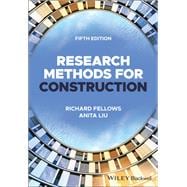Research Methods for Construction is designed to help construction students develop the research skills needed to achieve success in their research projects. Providing clear guidance on research formulation, methodologies, and methods, this comprehensive textbook addresses the theoretical, philosophical, and practical aspects of research in many areas of construction. The authors explain the requirements for data and analysis and describe the methods used for scientific and engineering experiments, modelling and simulations, research on management and socio-economic issues, and more.
Now in its fifth edition, Research Methods for Construction is fully revised to reflect contemporary developments and emerging areas of construction research. New and expanded chapters cover topics including data protection and ethics, theory borrowing, sensemaking, and directionally motivated reasoning. This edition includes additional models and details relating to translation, and offers fresh discussion of axiology, determinism, and stochasticism. Providing students with coherent, well-structured account of construction research, this market-leading textbook:
- Emphasizes and instils rigor into construction students' problem-solving, reports, and publications
- Assists researchers in selecting appropriate methods to execute research
- Articulates the stages of construction research processes: producing a proposal, executing the research, and reporting the results
- Examines qualitative and quantitative approaches and statistical considerations for a wide range of construction research
- Discusses current ethical, legal, and regulatory issues pertaining to research in construction
The fifth edition of Research Methods for Construction is the ideal textbook for advanced undergraduate and postgraduate students embarking on a research project, at bachelors, masters or doctoral level, in construction, surveying, architecture, civil engineering, and other built environment disciplines.









